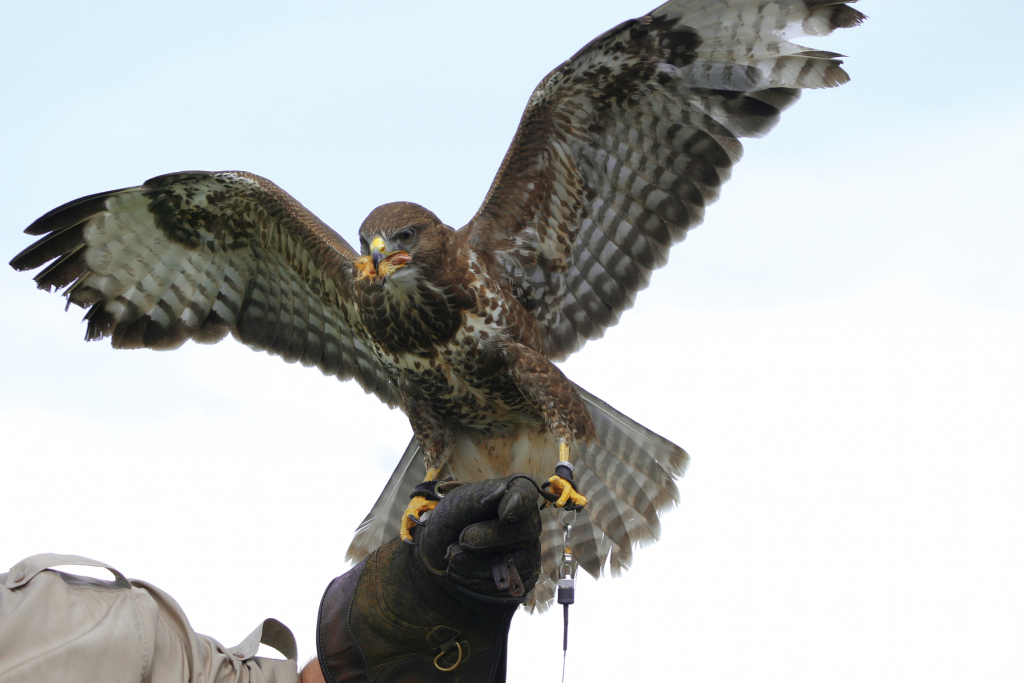
When not enjoying the Myoko Valley’s Nordic and Alpine sports, the Hawk & Hare owner’s favorite activities involve soaring through the sky. In the green season Michael Perrin can be found launching off hillsides on his paraglider, but his other passion, falconry, gives him a real bird’s-eye view into Myoko’s natural surroundings and allows guests at his inn the rare opportunity to practice this ancient art.
Most falconers in Japan and the West start simply because they like to hunt, Michael points out, although some modern hunters are drawn to falconry because it is a more ecological method of hunting than with a gun—or even a bow. But Michael says his attraction is not to the hunt, or even the art itself, but rather to these birds of prey, which in his words are “incredible creatures in both beauty and function.”
He began working with large hawks back the States and eventually flew falcons. Larger hawks are easier to train than falcons but, “The incredible flight of the peregrine is worth the time and effort,” he adds.
The art of falconry dates back thousands of years, with roots in Central Asia, as a form of subsistence hunting. Arab cultures, for instance, have a rich falconry tradition.
But due to Japan’s isolated location, falconry didn’t appear until the mid 300s when the Emperor Nintoku was presented a Chinese goshawk, a fast and versatile hunter, complete with training entourage. The imperial family practiced falconry until the Showa Period (1925-1989).
Today, very few schools still exist; most falconers live in Tokyo or Osaka and are limited to hunting pheasant or duck in these low-lying areas. Michael laments there is no licensing in Japan so, theoretically, people with zero knowledge can (expensively) order a bird online and lose it just as quickly. This is how many birds are lost. Furthermore, Japan only allows imported birds to be bought and sold, so the lost birds are haphazardly introduced into the environment.
In the USA, extensive testing at different levels is strictly required in order to fly birds. The Apprentice level enables the novice falconer to fly certain hawks (not on the endangered list). The General Falconer level permits the training of less common birds, and the highest grade, Master Falconer, allows the falconer to own a greater number and variety of birds. Most falconry groups in the U.K. are now looking at adopting such a system. Hopefully Japan will, too, in the future.
Like any traditional art, the process is more rewarding than the product. From the initial training through maturation, there is a learning process for both the bird and the human. As trust builds and skill develops, a tremendous bond forms, culminating in the thrill of flying these birds as they hunt for prey in their natural environment.
“The entire process allows a human to play a firsthand role in the development of these creatures’ magnificent power, skill, agility and hunting ability. It’s one of the most rewarding experiences you can have,” Perrin states.
The Hawk & Hare Inn is one of the few places where people interested in learning falconry can get introduced to the sport. The Myoko region is the perfect backdrop, as there are many designated areas for hunters and falconers.
Winter is the best time for falconry, as snow leaves clear tracks, and the ridges and valleys allow the hawk to soar easier.
As Michael points out, the art of falconry requires constant devotion but introductory courses teach valuable, first-hand knowledge, and apprenticeships and hunting outings are also available.
WEB CONNECTION
MYOKO
The official Myoko area Web site: www.myoko.tv
A personal site with excellent info on Myoko: www.klarbooks.com/guides/myoko/
FALCONRY
Falconry Forum is the most recognized network and most helpful for people with questions about falconry: www.falconryforum.co.uk
The International Association for Falconry and Conservation of Birds of Prey represents 63 falconry clubs from 48 countries worldwide, totaling 28,500 members. Web: www.i-a-f.org
The North American Falconers’ Association (NAFA) is the main club for falconry in the U.S., Canada and Mexico with members worldwide. Web: www.n-a-f-a.org
The National Conference for Japanese Falconry. Web: http://ncjf.sakura.ne.jp